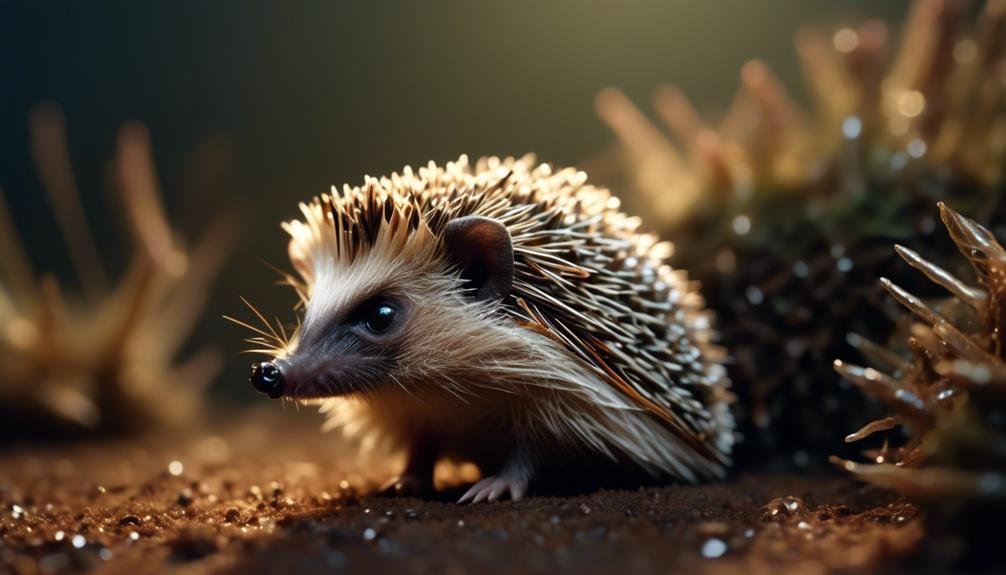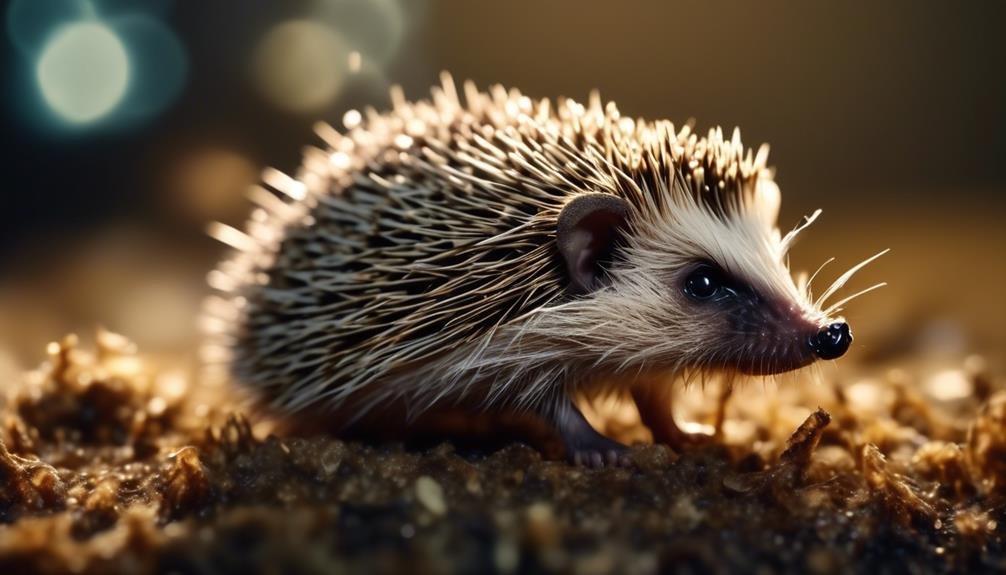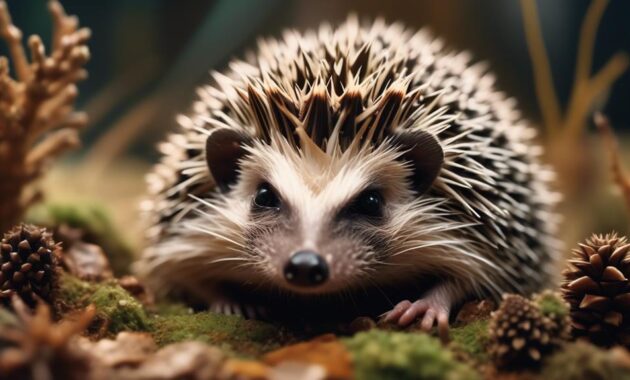
The northern white-breasted hedgehog, a relatively rare species found across Europe, has long captivated researchers with its intriguing characteristics. From its distribution and taxonomy to its size variation and the factors that influence it, this hedgehog species holds surprising secrets waiting to be unveiled.
Not only does it play host to a variety of parasites, some of which can transmit diseases, but it also carries zoonotic Bartonellae species and other pathogens. As we delve deeper into the lesser-known aspects of this species, we uncover a world of mysteries that shed light on the complex interactions between hedgehogs, their environment, and the potential impacts on human health.
Key Takeaways
- The northern white-breasted hedgehog is a separate species with five subspecies, previously considered a subspecies of E. europaeus and E. concolor.
- The size of the northern white-breasted hedgehog varies in Europe, with populations in southern Europe being larger than those in northern Europe. This size variation is influenced by temperature and precipitation.
- The hedgehog is a host for various parasites, including hedgehog ticks and European tick species, which can carry zoonotic Bartonellae species. The hedgehog’s fleas can also spread to cats and dogs, potentially affecting humans.
- Fleas found on the hedgehog have been tested positive for rickettsiae, Bartonella henselae, and hemoplasmas, indicating their potential role in transmitting these pathogens.
Distribution and Taxonomy of the Rare Hedgehog Species
The distribution and taxonomy of the rare hedgehog species, known as the northern white-breasted hedgehog (Erinaceus roumanicus), reveal intriguing insights into its range and classification.
The range of the northern white-breasted hedgehog extends to Poland, Austria, former Yugoslavia, Greece, Adriatic Islands, Russia, Ukraine, and Siberia. Notably, no significant population decline has been observed.
In the past, this species was considered a subspecies of E. europaeus and E. concolor, but it is now recognized as a separate species with five subspecies.
Variation in size has been observed within the species, with southern European populations being larger than those in northern Europe. This variation in size is influenced by temperature and precipitation, with larger sizes observed in higher temperatures and smaller sizes observed with higher summer precipitation.
The distribution and taxonomy of the northern white-breasted hedgehog provide valuable information for understanding its ecology and evolutionary history.
Size Variation and Influencing Factors
Size variation within the northern white-breasted hedgehog species is influenced by factors such as temperature and precipitation. Studies have shown that the size of these hedgehogs varies across Europe, with populations in southern Europe generally being larger than those in northern Europe.
Temperature has been found to play a significant role in this variation, with larger sizes observed in regions with higher temperatures. On the other hand, higher summer precipitation has been associated with smaller hedgehog sizes.
These findings suggest that environmental conditions, specifically temperature and precipitation, have a direct impact on the size of the northern white-breasted hedgehog species.
Further research is needed to understand the underlying mechanisms and the specific ways in which these factors influence size variation in these hedgehogs.
Parasites Associated With the Rare Hedgehog Species

Parasites commonly associated with the rare hedgehog species include hedgehog ticks (Ixodes hexagonus) and European tick species (Ixodes ricinus), which are known carriers of zoonotic Bartonellae species. These parasites pose a potential threat to both the hedgehogs and humans who come into contact with them. To provide a deeper understanding of the parasites associated with the rare hedgehog species, the following table presents an overview of the different parasites and their potential impact:
| Parasite | Carrying Species | Zoonotic Potential |
|---|---|---|
| Hedgehog ticks (Ixodes hexagonus) | Rare hedgehog species | Yes |
| European tick species (Ixodes ricinus) | Rare hedgehog species | Yes |
These parasites can transmit zoonotic Bartonellae species, which can lead to various health issues in both hedgehogs and humans. It is crucial to raise awareness about these parasites to ensure proper prevention and control measures are in place when interacting with the rare hedgehog species.
Synanthrope Species Carrying Hedgehog Ticks
As we further explore the parasites associated with the rare hedgehog species, it is essential to understand the synanthrope species that serve as carriers for hedgehog ticks. Among the common synanthrope species carrying hedgehog ticks are Ixodes hexagonus and Ixodes ricinus, which are also known to host zoonotic Bartonellae species.
It is worth noting that the white-breasted hedgehog’s fleas, specifically Archaeopsylla erinacei, can spread to cats and dogs, potentially affecting humans. In fact, fleas in investigation have tested positive for rickettsiae, Bartonella henselae, and hemoplasmas. Additionally, rickettsia helvetica, Bartonella henselae, and a rickettsia genotype have been identified in these fleas.
Therefore, understanding the synanthrope species that act as carriers for hedgehog ticks is crucial in further understanding the potential risks and implications for both humans and other animals.
Zoonotic Bartonellae Species in Hedgehogs

Zoonotic Bartonellae species pose potential risks and implications for both hedgehogs and humans. These bacteria are known to infect hedgehogs and can be transmitted to humans through direct contact or through vectors such as ticks and fleas.
Here are three key points to consider:
- Disease transmission: Hedgehogs can carry zoonotic Bartonellae species, including Bartonella henselae, which is responsible for causing cat scratch disease in humans. Transmission can occur through scratches, bites, or contact with contaminated fleas or ticks.
- Health impacts: In hedgehogs, zoonotic Bartonellae infections can lead to various health issues, including fever, anemia, and lymphadenopathy. These infections can also cause chronic diseases and may have long-term effects on the hedgehog population.
- Importance of prevention: To minimize the risk of zoonotic Bartonellae transmission, it is crucial to practice good hygiene when handling hedgehogs, especially if they show signs of illness. Regular veterinary care, flea and tick control, and proper handling techniques can help reduce the spread of these bacteria and protect both hedgehogs and humans.
Potential Effects on Cats and Dogs
The presence of zoonotic Bartonellae species in the fleas of the white-breasted hedgehog raises concerns about the potential effects on cats and dogs. Fleas, specifically Archaeopsylla erinacei, that infest the hedgehog can spread to other animals, including cats and dogs, and potentially affect humans. These fleas have been found to carry rickettsiae, Bartonella henselae, and hemoplasmas, posing a risk to the health of companion animals.
Bartonella henselae is known to cause cat scratch disease in humans, and it can be transmitted through flea bites. Therefore, if cats or dogs come into contact with hedgehog fleas, there is a possibility of contracting zoonotic infections. This highlights the importance of proper flea control measures and regular veterinary check-ups for pets to prevent the transmission of these pathogens.
Fleas in Investigation and Their Findings

During the investigation, the fleas found on the white-breasted hedgehog were tested, and the findings revealed the presence of various pathogens. These findings regarding the fleas provide valuable insights into the potential risks associated with these hedgehogs and their interactions with other animals, including humans.
Here are the key findings:
- The fleas tested positive for rickettsiae, Bartonella henselae, and hemoplasmas, indicating the potential transmission of these pathogens to other animals.
- Rickettsia helvetica, Bartonella henselae, and a rickettsia genotype were specifically identified in the fleas, highlighting the diversity of pathogens carried by these parasites.
- The presence of Archaeopsylla erinacei, the hedgehog flea, on these hedgehogs raises concerns about the potential spread of these fleas to cats and dogs, potentially affecting humans.
These findings emphasize the importance of understanding the role of fleas in the transmission of diseases and the need for further research to mitigate potential risks.
Positive Test Results for Rickettsiae and Bartonella
The detection of rickettsiae and Bartonella in the fleas found on white-breasted hedgehogs highlights the presence of these pathogens and their potential implications for disease transmission. Fleas are known to be common carriers of hedgehog ticks and European tick species, and they have been found to host zoonotic Bartonellae species.
In this investigation, fleas from white-breasted hedgehogs tested positive for rickettsiae, Bartonella henselae, and hemoplasmas. Specifically, rickettsia helvetica, Bartonella henselae, and a rickettsia genotype were identified in these fleas.
This discovery raises concerns about the potential spread of these pathogens to other animals, including cats, dogs, and potentially even humans. Further research is needed to better understand the transmission dynamics and potential health risks associated with these findings.
Identification of Specific Pathogens in Fleas

The presence of specific pathogens in fleas found on white-breasted hedgehogs has been identified, highlighting potential risks for disease transmission. The identification of these pathogens in fleas is of significant concern due to their potential to spread to other animals and even humans. Here are three key points to consider:
- Zoonotic potential: The fleas found on white-breasted hedgehogs, specifically Archaeopsylla erinacei, have the ability to spread to cats and dogs, raising concerns about potential transmission to humans as well.
- Pathogen variety: Fleas in investigation have tested positive for various pathogens, including rickettsiae, Bartonella henselae, and hemoplasmas. These findings indicate a diverse range of potential diseases that could be transmitted by these fleas.
- Specific pathogen identification: Among the identified pathogens, rickettsia genotype, Rickettsia helvetica, and Bartonella henselae have been found in the fleas. These specific pathogens can pose significant health risks to both animals and humans.
These findings emphasize the importance of understanding and managing the potential risks associated with the presence of pathogens in fleas, especially in the context of white-breasted hedgehogs and their potential interactions with other animals and humans.
References for Further Information
For further information on the topics discussed, the following references provide valuable insights into the distribution, taxonomy, variation, and parasites of the rare hedgehog species, including the northern white-breasted hedgehog:
- Wilson, D. E.; Reeder, D. M. (2005). Mammal Species of the World: A Taxonomic and Geographic Reference.
- Amori, G.; Hutterer, R.; Kryštufek, B.; Yigit, N.; Mitsainas, G.; Palomo, L. (2021). IUCN Red List of Threatened Species.
- Kryštufek, Boris; Tvrtković, Nikola; Paunović, Milan; Özkan, Beytullah (2009). Size variation in the Northern white-breasted hedgehog Erinaceus roumanicus: latitudinal cline and the island rule.
- Dumitrache, Mirabela Oana, et al. (2013). Northern White-Breasted Hedgehogs Erinaceus Roumanicus as Hosts for Ticks Infected with Borrelia Burgdorferi Sensu Lato and Anaplasma Phagocytophilum in Romania.
- Majerová, Karolina et al. (2021). Hedgehogs and Squirrels as Hosts of Zoonotic Bartonella Species.
These references provide comprehensive information on the distribution of the northern white-breasted hedgehog across Europe, its taxonomy as a separate species with five subspecies, the variations in size influenced by temperature and precipitation, and the parasites it carries, including hedgehog ticks and zoonotic Bartonella species. The references are valuable resources for further exploration of these intriguing aspects of the rare hedgehog species.
| Reference | Description |
|---|---|
| Wilson, D. E.; Reeder, D. M. (2005) | Provides a taxonomic and geographic reference for mammal species, including hedgehogs. |
| Amori, G.; Hutterer, R.; Kryštufek, B.; Yigit, N.; Mitsainas, G.; Palomo, L. (2021) | Offers information from the IUCN Red List of Threatened Species regarding the conservation status of hedgehogs. |
| Kryštufek, Boris; Tvrtković, Nikola; Paunović, Milan; Özkan, Beytullah (2009) | Explores the size variation of the northern white-breasted hedgehog and its relationship with latitude and the island rule. |
| Dumitrache, Mirabela Oana, et al. (2013) | Investigates the role of northern white-breasted hedgehogs as hosts for ticks infected with Borrelia Burgdorferi and Anaplasma Phagocytophilum. |
| Majerová, Karolina et al. (2021) | Focuses on hedgehogs and squirrels as hosts of zoonotic Bartonella species, providing insights into potential disease transmission. |
Conservation Status of the Rare Hedgehog Species

With its unique characteristics and intriguing ecological role, the rare hedgehog species warrants a comprehensive evaluation of its conservation status. The conservation status of the rare hedgehog species is of utmost importance to ensure its long-term survival and the maintenance of its ecological functions.
Here are three key points to consider:
- Population Distribution: The range of the northern white-breasted hedgehog extends across several European countries, but no significant population decline has been observed. Understanding the distribution of populations is crucial for targeted conservation efforts.
- Size Variation: The size of the hedgehog varies across Europe, with southern populations being larger than their northern counterparts. This size variation is influenced by temperature and precipitation, indicating the need to consider climate change impacts on the species.
- Parasites and Disease: The hedgehog hosts various parasites, including ticks and fleas, some of which can transmit zoonotic diseases. Monitoring and managing these parasites are essential for both hedgehog and human health.
Frequently Asked Questions
What Are the Specific Subspecies of the Rare Hedgehog Species?
The rare hedgehog species in question is the northern white-breasted hedgehog (Erinaceus roumanicus). It is recognized as a separate species with five subspecies. The specific subspecies of this hedgehog species are not mentioned in the given information.
How Does Temperature and Precipitation Influence the Size Variation of the Rare Hedgehog Species?
Temperature and precipitation significantly influence the size variation of the rare hedgehog species. Higher temperatures result in larger sizes, while higher summer precipitation leads to smaller sizes. This relationship underscores the species’ adaptability to its environment.
What Are the Zoonotic Bartonellae Species Found in Hedgehogs?
Zoonotic bartonellae species found in hedgehogs include Bartonella henselae. These bacteria can be transmitted to humans through flea bites or scratches from infected animals. It is important to take precautions when handling hedgehogs to prevent zoonotic infections.
Are There Any Known Effects on Cats and Dogs Caused by the Fleas From the Rare Hedgehog Species?
There are potential effects on cats and dogs caused by the fleas from the rare hedgehog species. The fleas, specifically Archaeopsylla erinacei, can spread to cats and dogs, potentially affecting humans. These fleas have tested positive for rickettsiae, Bartonella henselae, and hemoplasmas.
What Specific Pathogens Were Identified in the Fleas During the Investigation?
During the investigation, the fleas from the rare hedgehog species were found to carry various pathogens, including rickettsiae, Bartonella henselae, and hemoplasmas. These findings highlight the potential risk of transmission to cats, dogs, and humans.
How Does Hybridization in Southern White-Breasted Hedgehogs Affect the Northern White-Breasted Hedgehog Population?
The southern white-breasted hedgehog hybridizes wildlife, leading to potential genetic dilution for the northern white-breasted hedgehog population. This can result in a decrease in genetic diversity and potential adaptation to changing environments, posing a threat to the survival of the northern white-breasted hedgehog species.
Conclusion
In conclusion, the northern white-breasted hedgehog is a fascinating and relatively rare species found across Europe. It exhibits variation in size, influenced by factors such as temperature and precipitation.
The hedgehog harbors various parasites, including ticks and fleas, which can transmit diseases to other animals and potentially humans. Zoonotic Bartonellae species and other pathogens have been identified in hedgehog populations.
Further research is needed to better understand the ecological significance and conservation status of this intriguing species.




